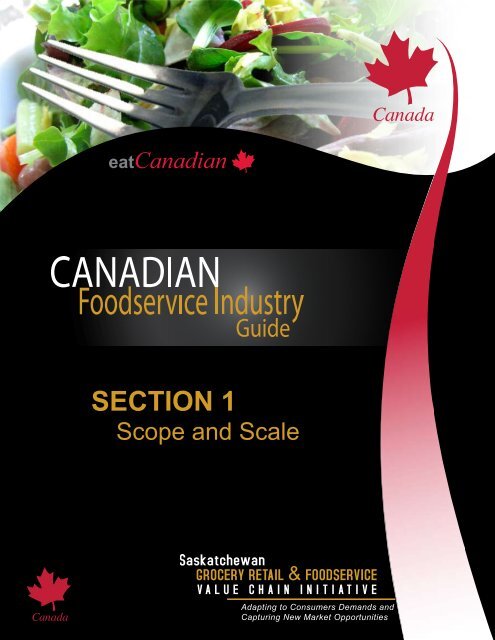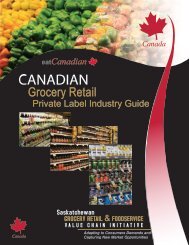SECTION 1 - Saskatchewan Grocery Retail and Foodservice Value ...
SECTION 1 - Saskatchewan Grocery Retail and Foodservice Value ...
SECTION 1 - Saskatchewan Grocery Retail and Foodservice Value ...
You also want an ePaper? Increase the reach of your titles
YUMPU automatically turns print PDFs into web optimized ePapers that Google loves.
<strong>SECTION</strong> 1<br />
Scope <strong>and</strong> Scale<br />
1
Scope <strong>and</strong> Scale<br />
Canadian <strong>Foodservice</strong> Channels:<br />
Descriptions<br />
The Canadian Restaurant & <strong>Foodservice</strong>s<br />
Association (CRFA) divides the Canadian<br />
<strong>Foodservice</strong> Industry (“the Industry”) into two<br />
general segments: Commercial <strong>and</strong> Non-<br />
Commercial, each with its own subcategories.<br />
Commercial foodservice represents<br />
approximately 79% of total industry sales <strong>and</strong><br />
includes:<br />
Full Service Restaurants (FSR): FSRs<br />
are restaurants where the customer’s order<br />
is taken at <strong>and</strong> delivered to a table. Some<br />
FSRs offer takeout <strong>and</strong> delivery service<br />
but table service is the mainstay of their<br />
business.<br />
Limited Service Restaurants (LSR):<br />
LSRs are restaurants where part or all of<br />
the transaction takes place at a counter or<br />
window. Modified counter service, where<br />
the order is taken at a counter but delivered<br />
to a table, is another example of an LSR.<br />
LSRs are sometimes referred to as QSR or<br />
Quick Service Restaurants.<br />
Section 1<br />
Together, FSR <strong>and</strong> LSR make up<br />
approximately 69% of the commercial<br />
foodservice industry in Canada.<br />
Caterers: Caterers comprise two<br />
separate <strong>and</strong> distinct groups: The first<br />
is Contract Caterers – companies that<br />
manage foodservices in institutions such<br />
as attractions, educational facilities,<br />
business <strong>and</strong> industry facilities, healthcare<br />
establishments, correctional facilities,<br />
remote camps <strong>and</strong> transportation facilities.<br />
The second is Social Caterers – companies<br />
that operate banquet halls, off-premise<br />
catering services or mobile catering<br />
vehicles.<br />
Drinking Places: This includes pubs,<br />
taverns <strong>and</strong> bars where the primary product<br />
being offered is alcoholic beverages but<br />
food is also served.<br />
Non-Commercial foodservices are operations<br />
whose primary business focus is not<br />
foodservice; food may be offered as a service<br />
or an amenity for the key stake holders of their<br />
operation. These include:<br />
Accommodation: This segment includes<br />
cafés, restaurants, bars, room service <strong>and</strong><br />
catering within hotels <strong>and</strong> resorts.<br />
<strong>Retail</strong>: This segment includes foodservice<br />
operations in retail venues such as<br />
department stores, convenience stores <strong>and</strong><br />
gas stations. This does not include br<strong>and</strong>ed<br />
foodservice concepts such as Tim Horton’s<br />
or Subway.<br />
Institutional: This segment includes<br />
all foodservice operations in institutions<br />
(e.g., attractions, educational facilities,<br />
business <strong>and</strong> industry facilities, healthcare<br />
establishments, correctional facilities,<br />
2
emote camps <strong>and</strong> transportation facilities)<br />
where the foodservices operations are<br />
operated by the institution itself (as opposed<br />
to a contract caterer).<br />
Canadian <strong>Foodservice</strong> Sales<br />
Section 1<br />
Other: Any other foodservice operation that<br />
is not classified as “Commercial”<br />
2010 Forecasted Sales Share by Segment<br />
3
Canadian <strong>Foodservice</strong> Industry sales<br />
were approximately $58.1 billion in 2009;<br />
representing roughly 4% of Canada’s GDP for<br />
that year.<br />
The CRFA forecasts industry sales of $60.1<br />
billion for 2010; a 3.1% increase.<br />
All <strong>Foodservice</strong>: Sales forecast by industry segment<br />
Nominal sales growth is defined as sales<br />
growth including inflation as a result of price<br />
increases.<br />
Total foodservice sales are expected to<br />
increase by 3.1% in 2010 compared to 2009.<br />
Accommodation is expected to achieve the<br />
highest nominal sales growth due to the<br />
anticipation of recovery in hotel occupancy<br />
rates after 2009 1 . Conversely, drinking places<br />
will likely see the lowest nominal growth.<br />
It is interesting to note that all non-commercial<br />
segments are expected to out perform the<br />
industry average in nominal growth.<br />
Section 1<br />
Significant years in this analysis are 1991<br />
(recession <strong>and</strong> the introduction of GST) <strong>and</strong><br />
2009 (recession). Other than these years, the<br />
foodservice industry has shown steady growth,<br />
doubling size in 20 years.<br />
1 Source: PKF Consulting: http://www.pkfcanada.<br />
com/trends_research/news_articles/2009/dec.html<br />
4
Commercial <strong>Foodservice</strong>: Top 50<br />
Operators’ share of units <strong>and</strong> revenue<br />
Historically, the top 50 commercial foodservice<br />
operators in Canada represent approximately<br />
one quarter to one third of industry units;<br />
however, they represent half of commercial<br />
Section 1<br />
foodservice sales. This illustrates the<br />
significant difference chain restaurants have<br />
in sales per restaurant over independent<br />
restaurants.<br />
5
Commercial <strong>Foodservice</strong>: Chains vs.<br />
Independents (Sales)<br />
Chains (defined as br<strong>and</strong>s operating three<br />
or more outlets) represent over 60% of<br />
commercial foodservice sales in all regions of<br />
Canada except Quebec.<br />
In Quebec, independent operators generate<br />
50% of sales; nevertheless, chain operator<br />
Section 1<br />
sales in Quebec are on the rise. It is only in<br />
recent years that Quebec independent sales<br />
have dropped to be equal or below that of<br />
chain operations; this is a sign of the growing<br />
significance of the chain restaurant model in<br />
today’s industry.<br />
6
Commercial <strong>Foodservice</strong>: Operating<br />
margins by operation classification<br />
Compared to many industries, the foodservice<br />
industry generates low net profits as a percent<br />
of total revenue. According to the 2009 CRFA<br />
Operations Report the average foodservice<br />
operation saw a net profit of<br />
only 4% of total revenue –<br />
1.6% lower than in 2000.<br />
Cost of Goods Sold (COGS),<br />
the cost of purchases of foods<br />
<strong>and</strong> beverages, represents<br />
the largest operating expense<br />
in all segments except for<br />
contract <strong>and</strong> social catering.<br />
Combined, COGS <strong>and</strong> labour<br />
costs equal almost 70% of<br />
revenue. The impact of these<br />
variables continues to grow.<br />
In 2000, COGS <strong>and</strong> labour<br />
were approximately 64% of<br />
sales.<br />
Section 1<br />
Food growers <strong>and</strong> processors<br />
wishing to sell to the foodservice<br />
market must recognize the<br />
challenge faced by operators in<br />
this regard.<br />
7
Commercial <strong>Foodservice</strong>: Share of<br />
Food Dollar – USA vs. Canada, % of<br />
meals away from home<br />
In 2009, Canadians spent 36.9% of their food<br />
dollar on food away from home (purchased in<br />
foodservice outlets as opposed to grocery retail<br />
outlets); this is the lowest share of food dollar<br />
since 1998.<br />
Overall the Canadian foodservice share of<br />
food dollar is declining. Conversely, food dollar<br />
share in the United States, typically higher than<br />
Canada’s to begin with, is gradually increasing,<br />
reaching 49% in 2009.<br />
[Interesting that US rose with poor economy,<br />
while Canada dropped. In fact adding a linear<br />
trend line shows Canada trending down while<br />
US trends upward.]<br />
Contract Caterers <strong>and</strong> Institutional<br />
<strong>Foodservice</strong>: Market share<br />
by segment<br />
Healthcare accounts for over 45%<br />
of the contract <strong>and</strong> institutional<br />
foodservice markets in Canada<br />
<strong>and</strong> remains primarily selfoperated.<br />
<strong>Foodservice</strong>s in remote camps,<br />
education, <strong>and</strong> business dining are<br />
most often operated by a contract<br />
caterer. Military <strong>and</strong> correctional<br />
foodservices are, for the most<br />
part, operated by the institutions<br />
themselves.<br />
Section 1<br />
8
For additional information pertaining to the <strong>Foodservice</strong> Guide, please contact:<br />
Bryan Kosteroski<br />
<strong>Value</strong> Chain Specialist<br />
Agriculture Council of <strong>Saskatchewan</strong><br />
104 - 411 Downey Road<br />
Saskatoon <strong>Saskatchewan</strong><br />
Canada S7N 4L8<br />
Office (306) 975-6851<br />
Cellular (306) 229-8986<br />
Email – kosteroskib@agcouncil.ca<br />
Website – www.saskvaluechain.ca<br />
The Agriculture Council of <strong>Saskatchewan</strong> (ACS) Inc. has developed this electronic guide for the Canadian<br />
foodservice industry as part of its continuing efforts to support the agriculture <strong>and</strong> agri-food industry <strong>and</strong><br />
develop the capacity <strong>and</strong> tools for food growers <strong>and</strong> processors to enter the foodservice industry.<br />
The purpose of the guide is to provide food growers <strong>and</strong> processors with a better underst<strong>and</strong>ing of the<br />
foodservice industry <strong>and</strong> how to tap into business opportunities within it. To that end, ACS has engaged<br />
fsSTRATEGY Inc., consultants to the foodservice industry, to help create this powerful reference tool.<br />
fsSTRATEGY is an alliance of senior consultants focusing on business strategy support – research,<br />
analysis, design <strong>and</strong> implementation – for the foodservice industry. Their team has extensive consulting<br />
experience in foodservice across Canada.<br />
Acknowledgements<br />
Geoff Wilson, B.Comm., CFE, CMC, ISHC fsSTRATEGY Inc.<br />
Andrew Waddington fsSTRATEGY Inc.<br />
www.saskvaluechain.ca<br />
DISCLAIMER<br />
WHILE EVERY EFFORT HAS BEEN MADE TO ENSURE ACCURACY, NONE OF THE SPONSORING<br />
AGENCIES OR AUTHORS ACCEPTS RESPONSIBILITY FOR ERRORS OR OMISSIONS. THE PUBLISHER,<br />
EDITORS AND ALL CONTRIBUTORS TO THIS PUBLICATION CANNOT BE HELD RESPONSIBLE FOR<br />
PUBLICATION ERRORS OR ANY CONSEQUENCES RESULTING FROM THE USE OF THIS PUBLICATION.<br />
ALL RIGHTS RESERVED. NO PART OF THIS PUBLICATION MAY BE REPRODUCED, STORED IN A<br />
RETRIEVAL SYSTEM, OR TRANSMITTED IN ANY FORM OR BY ANY MEANS, ELECTRONIC MECHANICAL<br />
PHOTOCOPYING, RECORDING OR OTHERWISE, WITHOUT WRITTEN PERMISSION FROM THE<br />
AGRICULTURE COUNCIL OF SASKATCHEWAN INC.<br />
© Copyright 2010<br />
Funding for this project has been provided by Agriculture <strong>and</strong> Agri-Food Canada through the<br />
Canadian Agricultural Adaptation Program (CAAP). In <strong>Saskatchewan</strong>, this program is delivered by the<br />
Agriculture Council of <strong>Saskatchewan</strong>.




